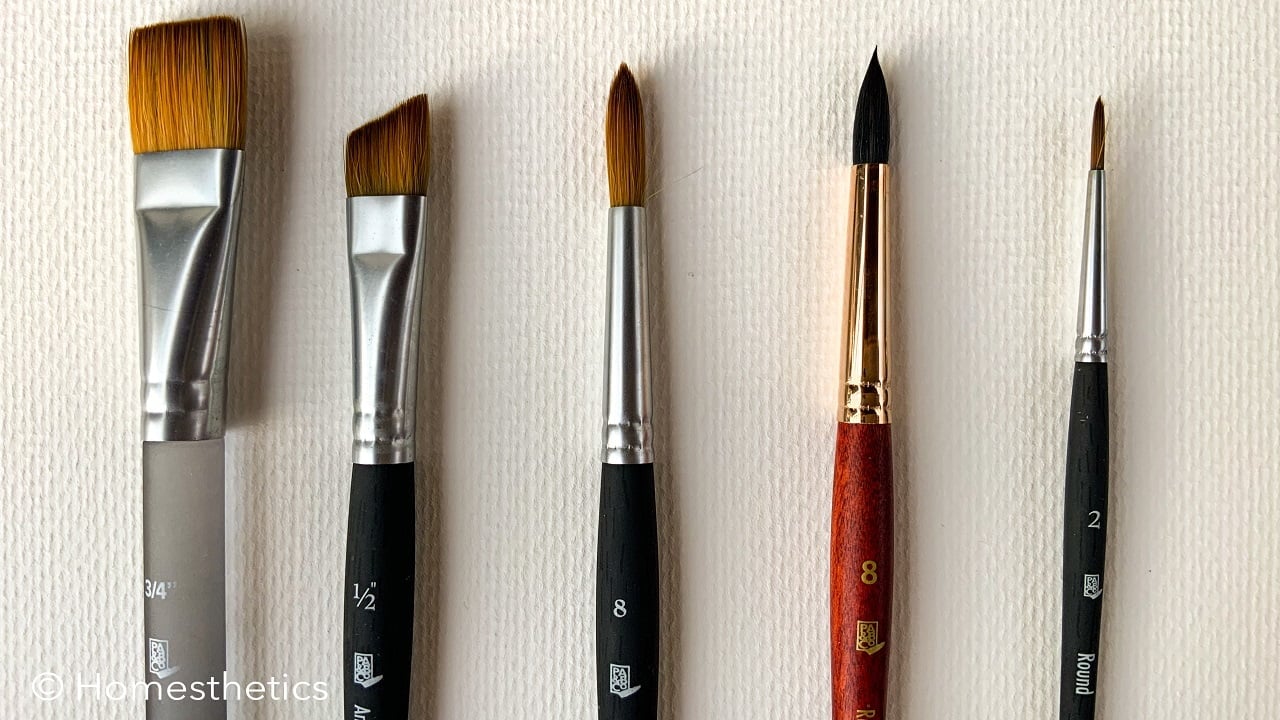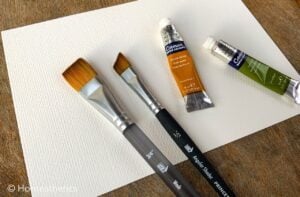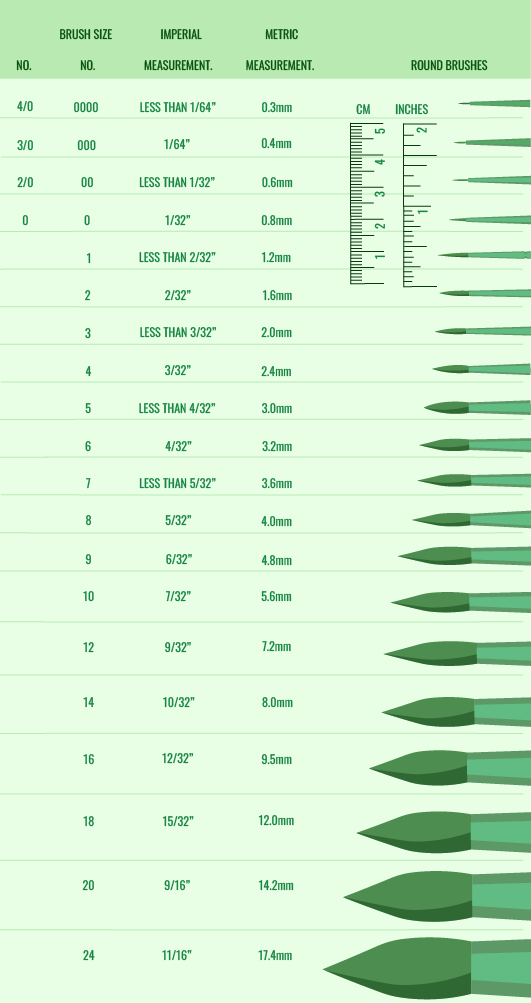Round brushes are great for creating detail and making thin lines, while flat brushes are helpful for broad strokes and sharp edges. Fan brushes are perfect for blending or creating texture, and Filbert brushes have a rounded edge that creates soft, blended strokes.

Choosing the right watercolor brush is crucial for creating a masterpiece. Brush sizes range from 000 to 24, but the numbering system may vary among brands. Beyond size, the shape of the brush impacts the type of stroke it creates, and there are different shapes such as round, flat, filbert, mop, fan, and dagger.
In this guide, I explain the different brush types most artists need and how to use a watercolor brush size chart.
Understanding The Shapes And Sizes of Brushes

Watercolor painting is an art form that demands a range of brush shapes to achieve diverse techniques and effects. Whilst round and flat brushes are the two most popular brushes employed by artists, as proficiency increases, it is advantageous to have access to a variety of good brushes.
It is a sophisticated art form requiring a comprehensive understanding of many factors to create a remarkable masterpiece. And among the several crucial elements is the selection of watercolor brush types, which come in a wide range of shapes, sizes, and hair types.
Before using brushes, you must acquaint yourself with the various dimensions and meanings. The numbering system employed for brush sizes may be confusing, but understanding it is essential. Brush sizes range from 000, the smallest size, to 24, the largest. However, note the numbering system may vary among different brands, so it is crucial to refer to the brand's size chart to ensure you are selecting the appropriate brush.
In addition to the brush sizes mentioned above, there are various other brushes that you may require for watercolor painting. It is advisable to have at least three round brushes of different sizes, as they are the most commonly used in watercolor painting.
1. Round Brushes
The round brush is the most versatile brush and is perfect for washes, broad strokes, and finer details. It comes in diverse shapes and sizes, making it suitable for various applications.
2. Flat Brushes
Flat brushes create broad linear strokes and lay-down washes, ideal for creating crisp or straight edges. The wash brush is also comparable to a flat brush but is much broader and ideal for effortlessly laying down large areas of washes.
3. Large Brushes
Large brushes such as the mop brush are advantageous for watercolor painting. The mop brush is a thick-bellied brush that can hold significant water and pigment, making it beneficial for washes. While it only sometimes has a fine point, the more expensive ones do.
4. Rigger brush
The rigger brush, a round brush with long hair and a fine point, is perfect for long lines, scrollwork, and other fine details. Despite its small size, it can hold a good amount of water. Lastly, the angled brush, resembling a flat brush with an angled shape, helps paint sharp corners, edges, and curved strokes. It is also beneficial for flat washes.
5. Filbert brush
The filbert brush is another flat brush with an oval shape that can be useful for blending. Its rounded head makes it helpful in painting soft round edges such as the petals of flowers. The cat's tongue brush is a two-in-one, flat brush with a fine and pointy tip, just like a cat's tongue! The fan brush is also flat but has widely spread hair fanning in a semi-circle shape, making it great for creating textural effects.
6. Spotter brush
The spotter brush is a detail paintbrush with fine and short hair, making it useful for small and minute detail work. It is also used as a "retouching" brush for minor corrections. The hake brush is originally from Japan and is similar to a wash brush, wide and great for painting big swatches of washes.
Things To Note
Watercolor brushes have smaller and shorter handles than those used for oil and acrylic painting. Most watercolor artists like to work on smaller-sized paintings, which requires them to work closely on the paper or surface.
Holding the brush at the ferrule provides optimum control and balance, so a long and heavy handle is not recommended. When deciding on a watercolor brush, it is essential to consider factors beyond just its size. The shape of the brush significantly impacts the type of stroke it creates, which in turn affects the overall texture and appearance of the painting.
Along with the brushes, other art supplies, such as the paint palette, should also be considered to achieve the best results.
Watercolor Brush Size Chart

| NUMBER | BRUSH SIZE NUMBER | IMPERIAL MEASUREMENT | METRIC MEASUREMENT |
|---|---|---|---|
| 4/0 | 0000 | less than 1/64" | 0.3mm |
| 3/0 | 000 | 1/64" | 0.4mm |
| 2/0 | 00 | less than 1/32" | 0.6mm |
| 0 | 0 | 1/32" | 0.8mm |
| - | 1 | less than 2/32" | 1.2mm |
| - | 2 | 2/32" | 1.6mm |
| - | 3 | less than 3/32" | 2.0mm |
| - | 4 | 3/32" | 2.4mm |
| - | 5 | less than 4/32" | 3.0mm |
| - | 6 | 4/32" | 3.2mm |
| - | 7 | less than 5/32" | 3.6mm |
| - | 8 | 5/32" | 4.0mm |
| - | 9 | 6/32" | 4.8mm |
| - | 10 | 7/32" | 5.6mm |
| - | 12 | 9/32" | 7.2mm |
| - | 14 | 10/32' | 8.0mm |
| - | 16 | 12/32 | 9.5mm |
| - | 18 | 15/32" | 12.0mm |
| - | 20 | 9/16" | 14.2mm |
| - | 24 | 11/16' | 17.4mm |
A watercolor brush can be found in various sizes and shapes, each designed for different purposes. As a beginner, it can be overwhelming to decide which brush to use for a particular painting. This is where a watercolor brush size chart comes in handy.
A brush size chart is a useful tool for selecting suitable watercolor brushes for your artwork. The chart provides a visual representation of different brush sizes and shapes, allowing you to choose the appropriate brush for specific areas of your painting.
To use the chart, first identify the type of brush you need, such as a round, flat, or filbert. Then, use the chart to compare the sizes of brushes within that category. Generally, larger brushes are best for painting broad strokes and washes, while smaller brushes are ideal for fine details and delicate lines.
By using a brush size chart to select your watercolor brushes, you can ensure that you have the right tools for your artistic vision. Watercolor painting is a delicate and intricate art form that requires skill, patience, and the right tools.
Tip
When selecting a brush size, consider the size of your painting and the level of detail you want to achieve. A smaller brush may be more appropriate for intricate work, while a larger brush can cover more area quickly.
Tips for Using Watercolor Brushes
Watercolor brushes are essential tools for any artist working with watercolor paints. However, to get the best results from your brushes, it is essential to use them correctly and take good care of them.
Here are some tips for using watercolor brushes:
1. Choose The Right Brush
Watercolor brushes come in various sizes and shapes, each designed for a specific purpose. There are some common shapes such as round, flat, etc. For instance, a round brush is ideal for creating fine details, while a flat brush is great for laying down large washes. Choose a brush that fits the task at hand.
2. Wet Your Brush
Before dipping your brush into the paint, it is essential to wet it first to help the paint flow more smoothly and evenly.
3. Mix Your Paint
Dip your brush into the paint, then mix it on the palette to create the desired color and consistency.
4. Use The Right Amount Of Water
Watercolor paints require a delicate balance of water and pigment. More water will make the paint too thin and runny, while more water will make it too thick and difficult to work with. Experiment with different ratios of water and paint until you find the right balance.
5. Clean Your Brushes
After each use, rinse your brushes thoroughly with water to remove any excess paint. Use a mild soap or brush cleaner to remove stubborn stains.
6. Store Your Brushes Properly
When not using them, store them upright in a jar or brush holder. Avoid leaving them in a water cup or letting them rest on their bristles, as this can damage the brushes.
7. Keep Your Brushes In Good Condition
To keep your brushes in good condition, avoid using them to stir paint and refrain from applying excessive pressure when painting. If the bristles become frayed or damaged, trim them with scissors or replace the brushes altogether.
8. Use A Variety Of Brush Strokes
Experiment with different brush strokes to create different effects. Try dry brushing, splattering, or stippling to add texture and depth to your paintings.
A watercolor brush size chart is a handy reference tool for artists to quickly identify and choose the appropriate brush size for their painting. Match the brush sizes on the chart to the actual size of the brush you plan to use. Using a watercolor brush size chart helps artists to save time, choose the right brush for the job, and avoid mistakes such as using a brush that is too large or small for the desired effect. To make your watercolor brush size chart, gather your brushes and arrange them in size order. Then, use a ruler to measure each brush and write down the size next to it. You can design a chart on white paper or use a spreadsheet on your computer. Consider the size of the area you want to paint, the level of detail you want to achieve, and the techniques you plan to use. Generally, smaller brushes are better for detailed work, while bigger brushes are better for covering large areas. Round brushes with a pointed tip are ideal for creating fine lines, details, and curves. Flat brushes have a rectangular tip and are better for covering large areas, creating washes, and straight edges. You can use the same brush size for different techniques, but the results may vary depending on the available painting area and the level of detail you want to achieve. Watercolor Brush Size Chart FAQs

Conclusion
Selecting the appropriate watercolor brush is crucial for creating exceptional artwork. Consideration should be given to factors such as brush size, shape, hair type, and personal style.
A watercolor brush size chart can be helpful for beginners and experienced artists to make the right choice. Moreover, by caring for and using brushes correctly, experimenting with different strokes or techniques, and selecting the right brush for the job, you can achieve beautiful results.
